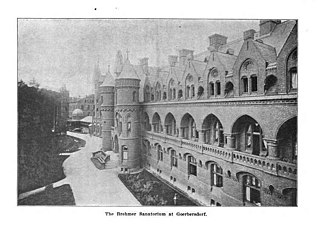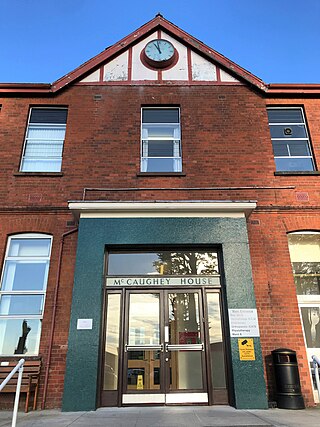
A sanatorium, also sanitarium or sanitorium, is a historic name for a specialised hospital for the treatment of specific diseases, related ailments and convalescence. Sanatoriums are often in a healthy climate, usually in the countryside. The idea of healing was an important reason for the historical wave of establishments of sanatoriums, especially at the end of the 19th- and early 20th centuries. One sought, for instance, the healing of consumptives especially tuberculosis or alcoholism, but also of more obscure addictions and longings of hysteria, masturbation, fatigue and emotional exhaustion. Facility operators were often charitable associations such as the Order of St. John and the newly founded social welfare insurance companies.
Piedmont Sanatorium was a rest home for tubercular African Americans in Burkeville, Virginia from 1917 to 1965. It was the first facility of its kind ever to be established in the United States. The Sanatorium later became the site of Piedmont Geriatric Hospital.
Tambaram Sanatorium is a southern suburb of Chennai, India. Located between Chromepet and Tambaram, the neighbourhood is served by Tambaram Sanatorium railway station on the Chennai Beach–Villupuram section via Tambaram of the Chennai suburban railway.

Olive View–UCLA Medical Center is a hospital, funded by Los Angeles County, located in the Sylmar neighborhood of Los Angeles, California. It is one of the primary healthcare delivery systems in the north San Fernando Valley, serving the area's large working-class population. Olive View is also the closest county hospital serving the Antelope Valley after High Desert Hospital was converted to an urgent care clinic in 2003.

The University Hospital of South Manchester NHS Foundation Trust is a defunct NHS foundation trust that previously operated Wythenshawe Hospital, a major acute teaching hospital in Wythenshawe, Manchester. Many of the services and facilities previously at Withington Hospital were transferred to Wythenshawe in 2004. It provided services for adults and children at Wythenshawe Hospital and Withington Community Hospital. It runs Buccleuch Lodge Intermediate Care Unit and the Dermot Murphy Centre in Withington, and the Specialised Ability Centre in Sharston.
Kenya's health care system is structured in a step-wise manner so that complicated cases are referred to a higher level. Gaps in the system are filled by private and church run units.

Hawkmoor Hospital, originally known as Hawkmoor County Sanatorium, was a specialist hospital near Bovey Tracey in Devon, England, founded in 1913 as a pulmonary tuberculosis sanatorium as part of a network of such facilities, instigated by the Public Health 1912. From 1948, the hospital catered for patients with a range of chest ailments, as well as chest surgery, and mental disability patients. From 1973, the facility dealt solely with mental health problems until its closure in 1987.
George Marshall McCall Smith (1882–1958) was a Scottish medical doctor, medical superintendent and community leader in New Zealand. He was born in Nairn, Scotland in 1882, emigrating to New Zealand in 1914. For 34 years he ran Rawene Hospital, campaigned for state funding of health and is remembered for creating a health service for the remote Hokianga area.
The Rutland Heights State Hospital was a state sanatorium for the treatment of pulmonary tuberculosis located in Rutland, Massachusetts, USA built for the purpose of treating Tuberculosis patients. The facility was the first state-operated sanatorium in the United States, opening in 1898 and operating for around 93 years before its closure in 1991. Rutland Heights opened under the title “Massachusetts Hospital for Consumptives and Tubercular Patients,” to which it operated until 1900, where it was renamed to “Massachusetts State Sanatorium.” In 1919 it was renamed to “Rutland State Sanatorium,” which was the longest operating name of the hospital, effective until 1963. In 1963, it was renamed briefly to “Rutland Hospital,” and successively in 1965 to “Rutland Heights State Hospital,” which was the final title of the hospital until closing. In 2004, the hospital was demolished.

The Indian hospitals were racially segregated hospitals, originally serving as tuberculosis sanatoria but later operating as general hospitals for indigenous peoples in Canada which operated during the 20th century. The hospitals were originally used to isolate Indigenous tuberculosis patients from the general population because of a fear among health officials that "Indian TB" posed a danger to the non-indigenous population. Many of these hospitals were located on Indian reserves, and might also be called reserve hospitals, while others were in nearby cities.
Government Hospital of Thoracic Medicine, popularly known as the Tambaram TB Sanatorium, is a major state-owned hospital situated in Chennai, India. The hospital is funded and managed by the state government of Tamil Nadu. It was founded in 1928.
The town of Colorado Springs, Colorado, played an important role in the history of tuberculosis in the era before antituberculosis drugs and vaccines. Tuberculosis management before this era was difficult and often of limited effect. In the 19th century, a movement for tuberculosis treatment in hospital-like facilities called sanatoriums became prominent, especially in Europe and North America. Thus people sought tuberculosis treatment in Colorado Springs because of its dry climate and fresh mountain air. Some people stayed in boarding houses, while others sought the hospital-like facilities of sanatoriums. In the 1880s and 1890s, it is estimated that one-third of the people living in Colorado Springs had tuberculosis. The number of sanatoriums and hospitals increased into the twentieth century. During World War II, medicines were developed that successfully treated tuberculosis and by the late 1940s specialized tuberculosis treatment facilities were no longer needed.

The Oregon State Tuberculosis Hospital was a tuberculosis sanatorium in Salem, Oregon, United States. Established in 1905, it was the first public tuberculosis sanatorium on the West Coast. The main hospital building, constructed in 1894, had formerly housed the Oregon State Deaf-Mute School. After its conversion into the state tuberculosis hospital, multiple cottages and additional buildings were constructed on the property. The hospital remained in operation until 1969, when it was purchased by Corban University.

The Firland Sanatorium was Seattle's municipal tuberculosis treatment center. It opened on May 2, 1911, and closed on October 30, 1973.

Dr Pearl Dunlevy, was an Irish physician and epidemiologist working on TB and was the first woman president of the Biological Society of the Royal College of Surgeons of Ireland.

Whiteabbey Hospital is a hospital located close to the village of Whiteabbey, within the town of Newtownabbey, Northern Ireland. The hospital first opened in 1907 as The Abbey Sanitorium, centred around a country house known as 'The Abbey'. The house has stood on the site from 1850, and was once the residence of prominent architect Charles Lanyon. The hospital was extended and several buildings added throughout the early 20th century, and it was renamed Whiteabbey Hospital in 1947. The hospital is managed by the Northern Health and Social Care Trust. Many healthcare services have been withdrawn from the hospital, most recently with the closure of the Minor Injuries Unit in 2014.
Whipton Hospital is a small community hospital, also known as the Exeter Community Hospital (Whipton). It was founded as the Whipton Isolation Hospital in 1913 as a pulmonary tuberculosis sanatorium as part of a network of such facilities, instigated by the Public Health (Tuberculosis Regulations) 1912.

The Honeylands, originally the Honeylands Children's Sanatorium and later the Honeylands Children's Centre was a hospital in Exeter, Devon used as a children's pulmonary tuberculosis sanatorium, later used for treatment of children with learning difficulties. Adults were treated at the nearby Whipton Hospital.
The Heavitree isolation hospital, also for a time known as the Exeter Corporation Tuberculosis Sanatorium, was a small pulmonary tuberculosis sanatorium located on Hollow Lane, Exeter, United Kingdom. The site is a few hundred metres to the west of the Whipton Hospital.

The Sanatorium in Smukała is a hospital for pulmonary diseases located in the district of Smukała, Bydgoszcz, Poland. Located in a conifer forest, it operated as an independent institution between 1904 and 2000, before being integrated into the structures of the Kuyavian-Pomeranian Center of Pulmonology.












